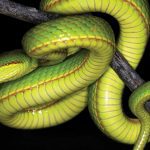 Pop Culture
Pop Culture  Pop Culture
Pop Culture  Animals
Animals 10 Remarkable Things We’ve Recently Learned about Animals
 Weird Stuff
Weird Stuff 10 Reasons the Psychic Internet Theory Will Blow Your Mind
 Movies and TV
Movies and TV Television’s Top Ten Most Ruthless Serial Killers
 Weird Stuff
Weird Stuff Ten of the Strangest Paraphilias Ever Documented
 Miscellaneous
Miscellaneous 10 Interesting Physics Facts about Bullets
 History
History 10 Oddest Naval Actions in History
 Music
Music 10 “Bands” That Are Actually Just One Person
 History
History Ten Uprisings Led by Women
 Creepy
Creepy Top Ten Creepiest Dolls in History
 Pop Culture
Pop Culture Ten Celebrities Who Straight-Up Lied on Home Tours
 Animals
Animals 10 Remarkable Things We’ve Recently Learned about Animals
 Weird Stuff
Weird Stuff 10 Reasons the Psychic Internet Theory Will Blow Your Mind
Who's Behind Listverse?

Jamie Frater
Head Editor
Jamie founded Listverse due to an insatiable desire to share fascinating, obscure, and bizarre facts. He has been a guest speaker on numerous national radio and television stations and is a five time published author.
More About Us Movies and TV
Movies and TV Television’s Top Ten Most Ruthless Serial Killers
 Weird Stuff
Weird Stuff Ten of the Strangest Paraphilias Ever Documented
 Miscellaneous
Miscellaneous 10 Interesting Physics Facts about Bullets
 History
History 10 Oddest Naval Actions in History
 Music
Music 10 “Bands” That Are Actually Just One Person
 History
History Ten Uprisings Led by Women
 Creepy
Creepy Top Ten Creepiest Dolls in History
10 Remarkable Things We’ve Recently Learned about Animals
Animals consistently impress us with their abilities and cognition. As a result, science has come a long way since people believed flies spontaneously generated from beef. Or that anteaters came from the moon.
Fortunately, the tide of animal discovery hasn’t slowed but gained traction as human comprehension scrutiny has improved. The following include some of the most remarkable things we’ve recently learned about the various critters that share our wild and wacky world.
Related: 10 Amazing Ways That Animals Are Smarter Than You May Realise
10 Animals Self-Medicate at “Forest Pharmacies”
Science is great because it helps us learn about self-medicating monkeys. Science also creates cool words for basic things, like your cat or dog eating grass. Formally, this is called “zoopharmacognosy,” the animal self-medication your pets perform when they have a tummy ache.
Although animal self-medication is common throughout the wild world. One fascinating example revolves around Leontopithecus chrysopygus, aka the black lion tamarin, aka the golden-rumped tamarin. These small, threatened Brazilian primates rub themselves against the Myroxylon peruiferum tree to spread its resin over their bodies. It’s not just because the tree (locally called cabreúva) smells of cinnamon, cloves, and honey. It’s because it has “antibiotic, anti-inflammatory, and anti-parasitic properties.”
But it wasn’t just the tamarins self-medicating. Camera traps caught numerous other animals licking and rubbing the trees, including ocelots, anteaters, peccaries, and at least seven other species. The pig-like peccaries, for example, “spread resin on each other’s fur in pairs and head to head.” How romantic.[1]
9 Crab Spiders Engage in “Collective Camouflage”
Crab spiders earned their name because they sidle and scuttle like crabs. They are, however, firmly entrenched in the spider family—no need for the meme-worthy evolutionary act of carcinization here, thank you very much.
Regardless, these animals have potentially just given science a “first.” In this case, the first evidence of collective camouflage by spiders. In the tropical forests of China’s Yunnan province, scientists found something that initially didn’t seem too odd: a male spider sitting atop a female spider. Good for him. Yet these spiders, scientifically known as Thomisus guangxicus, may form a “joint illusion” as the male and the female have complementary colors.
When males want to mate, they approach the females that are minding their own business on flower petals. If their colors contrast too heavily, the male risks getting eaten by lizards, wasps, or birds; being a tiny crab spider isn’t easy. But if the colors complement, the spiders can avoid predators while also ambushing their own prey, insects. The mating is a bonus.[2]
8 Starfish: Where’s the Head?
New Stanford research has delved deep into an arcane and abstruse question about starfish: Where’s the head? In the center? Maybe somewhere inside one of the arms? The answer is everywhere and nowhere at the same time.
The Stanford study used “genetic and molecular tools” to make a 3D atlas of starfish gene expression to get to the bottom of this Asteroidea mystery. Fun fact: that’s the scientific name for starfish, meaning “star-like” in Greek.
The study found that “the headlike regions are distributed with some in the center of the sea star as well as in the center of each limb of its body.” Yet, hard as it may be to believe, science says we humans are closely related to the group of animals that includes starfish, echinoderms, or spikey-skinned creatures.[3]
7 Even Mutts Can Sniff out Sickness
Your pooch has an incredible sense of smell, potentially 100,000 times more capable than the best human smellers. Dogs use this supreme sense of smell to identify each other, discern territories, discover bacon, and sniff out disease.
The last one is important, and it’s known that highly trained canines can detect things like malaria, COVID-19, and some cancers. Recently, and even more importantly, it’s been found that plain-old pet dogs, with no pure-breeding required, can also learn to smell disease with up to 90% accuracy.
Parkinson’s is a debilitating neurological disease affecting 10 million people, with 90,000 new cases a year. How do dogs sniff it out? People with Parkinson’s have “unique chemicals in their sebum,” an oily body fluid. Researchers trained 16 breeds (including Pomeranians and English mastiffs) to identify the disease with an 86% success rate.[4]
6 Termite Mating Hasn’t Changed in 40-Million-Odd Years
Amber fossils are incredible because of their chance of occurrence. They capture moments in time, sometimes millions of years back, and let us all glimpse long-gone eons.
Globs of exceedingly old tree resin help create some of the most amazing fossils ever discovered, including the find of a lifetime for bug lovers and lover-bugs: two termites trapped in a terminal, now-eternal embrace.
The amorous couple was immortalized while mating some 38 million years ago. The termites are called Electrotermes affinis, and the weird thing about them is their side-to-side position. Rather than following each other, the two termites tell researchers that the termitic mating tactic hasn’t changed in all this time.
To test the hypothesis, scientists watched living termites perform mating behaviors (and other activities) on a sticky surface. It’s not my ideal job, but hey, you do you.[5]
5 Cats Like Fetching (When They Feel Like It)
In a fascinating science story seemingly conducted for the amusement of researchers, cats like to play fetch. But they’re very picky about it, according to a survey encompassing more than 900 cat owners.
The research from the journal Scientific Reports states that most cat owners found that their felines learned fetching behaviors on their own, without instruction. The study explored the “animals’ agency,” seeking to discover who more often initiates the fetching: owners or their cats. The answer may not surprise those who frequently frolic with felines, as per Science News Explores. “The survey tallied data from 1,154 cats. Their owners reported that more than 94% hadn’t been trained to fetch.”
Intriguingly, Siamese cats were the most likely to fetch objects. Such activities are a fantastic way for interspecies bonding and keeping kitties entertained and fulfilled.[6]
4 Animal Remains in Idaho Lake May Help Identify Ancient Martian Life
This discovery comes courtesy of a lake that existed long ago. Around 16 million years prior, a lava flow plugged a narrow, steep-sided valley and allowed a lake to flow. The Clarkia Miocene Lake region gained the perfect depth and created an environment that jealously guarded its mix of “microbial, plant and animal remains that fell to the lake’s bottom.” So well that some of the recovered leaves still held their autumnal colors.
Other important stuff was also found, like the remnants of fats, fibrous plant tissue, and maybe even some DNA. This could provide an amazing analog for how we try to discover past life on Mars. Our red neighbor also had lakes, and these sediments may have trapped dead little bodies or other signs of any microorganisms that may have existed.
More specifically, researchers say that Clarkia has similar conditions, including chemicals and rock types akin to Mars’ Jezero Crater. Additionally, these Martian rocks formed under “a climate with higher temperatures, high humidity, and a carbon dioxide-rich atmosphere.” The biomarkers found at Clarkia could help scientists create a detection threshold for Martian biomarkers at Jezero and elsewhere.[7]
3 The Adorably Tiny Andean Deer
The remote valleys of the Andes are home to all sorts of wonders, including a deer so dwarfish that it seems to be designed by Pixar.
The Peruvian dwarf deer is named Pudella carlae and is almost unbelievably small. It’s dog-sized, standing only about 15 inches (38 centimeters) tall and weighing a measly 22 pounds (10 kilograms).
It’s part of the “pudu” discipline of deer, the world’s smallest deer group, and a major milestone in terms of animal discoveries. It was the first fresh cervid (deer member) described in 60 years. Who knew these discoveries were so rare?
The diminutive deer belongs to an intriguing and diverse home, the “Huancabamba Depression, a broad and arid river valley that divides the Andes in northern Peru.” This dry valley may only be about 30 miles (49.3 kilometers) across, but that doesn’t limit its ecological creativity. It’s a haven that hosts hundreds of endemic species of plants and animals. Are any as endearing as this deer? That’s a matter for an entirely different branch of science, adorab-ology.[8]
2 Do Flowers Act as “Antennas” for Bees?
Here’s a crazy idea that some scientists are exploring: the relationship between bees and plants may be more complex than most could imagine. This supposition is all thanks to novel thinking about bees and flowers sharing electricity, as it were.
A study suggests that flowers could be the equivalent of big antennas for the electrical signals produced by bees. Once a bee “gives” or transmits its charge to a flower, that electric signal is channeled through it, down into the soil, and to other flowers. Why? Perhaps to drive pollination by letting flowers decide to make their goods more available for pollinators. No contact is necessary, as even the bees’ flapping wings could trigger a tiny voltage difference.
Not everyone is convinced, however, and much more work needs to be done. Still, the idea of electrical communication (rather than chemical) between flowers could be significant if true. [9]
1 Sperm Whales Diarrhea Their Way to Safety
A fantastic event occurred around the southern coast of Western Australia: A group of sperm whales pooped their way to safety. And, well, the article describes it quite eloquently. The whales diverted their attackers with a “bubble of poo.”
When up to 30 killer whales accosted a pod of sperm whales, the latter ensured their well-being with a “rosette,” a group formation with their heads facing the middle and their tails outward. Scientists call this interesting technique “defensive defection,” which involves releasing a “cloud of diarrhea.”
The sperm whales’ squid-focused diet gives them reddish-colored poops, which they swish into a maelstrom by flapping their flukes. Yet all this intrigue was prefaced by a scare; the reddish bubble of diarrhea was at first thought to be blood. But later review revealed that the whales were just fine, if a bit smellier, thanks to their innovative defense maneuver. Coincidentally, orcas attacking the bigger sperm whales is rare but seems to be becoming more common. Could a similar tactic be the next step in human evolution? I sure hope so.[10]








